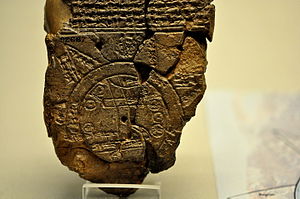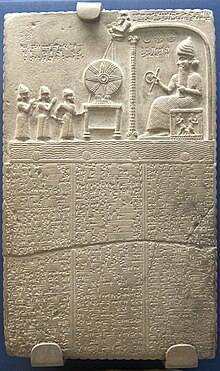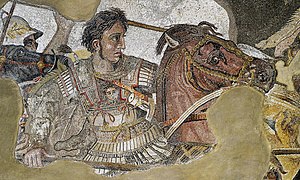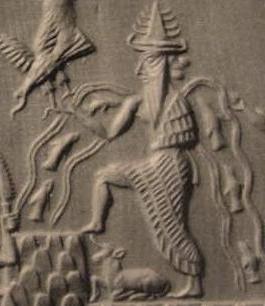
Enki is the Sumerian god of water, knowledge (gestú), crafts (gašam), and creation (nudimmud), and one of the Anunnaki. He was later known as Ea or Ae in Akkadian (Assyrian-Babylonian) religion, and is identified by some scholars with Ia in Canaanite religion. The name was rendered Aos in Greek sources.
Akkadian literature is the ancient literature written in the Akkadian language in Mesopotamia during the period spanning the Middle Bronze Age to the Iron Age.

Marduk is a god from ancient Mesopotamia and patron deity of Babylon who eventually rose to power in the 1st millennium BC. In Babylon, Marduk was worshipped in the temple Esagila. His symbol is the spade and he is associated with the Mušḫuššu.
Zecharia Sitchin was an author of a number of books proposing an explanation for human origins involving ancient astronauts. Sitchin attributed the creation of the ancient Sumerian culture to the Anunnaki, which he stated was a race of extraterrestrials from a planet beyond Neptune called Nibiru. He asserted that Sumerian mythology suggests that this hypothetical planet of Nibiru is in an elongated, 3,600-year-long elliptical orbit around the Sun. Sitchin's books have sold millions of copies worldwide and have been translated into more than 25 languages.

In Mesopotamian religion, Tiamat is the primordial sea, mating with Abzû (Apsu), the groundwater, to produce the gods in the Babylonian epic Enûma Elish, which translates as "when on high." She is referred to as a woman, and has—at various points in the epic— a number of anthropomorphic features and theriomorphic features.

In the Babylonian epic Enuma Elish, Kishar is the daughter of Abzu and Lahmu, the first children of Tiamat and Abzu. She is the female principle, sister and wife of Anshar, the male principle, and the mother of Anu. Kishar may represent the earth as a counterpart to Anshar, the sky, and can be seen as an earth mother goddess. Her name also means "Whole Earth".

Enūma Eliš, meaning "When on High", is a Babylonian creation myth from the late 2nd millennium BCE and the only complete surviving account of ancient near eastern cosmology. It was recovered by English archaeologist Austen Henry Layard in 1849 in the ruined Library of Ashurbanipal at Nineveh. A form of the myth was first published by English Assyriologist George Smith in 1876; active research and further excavations led to near completion of the texts and improved translation.
Anshar was a Mesopotamian god regarded as a primordial king of the gods. He was not actively worshiped. He was regarded as the father of Anu. In the first millennium BCE his name came to be used as a logographic representation of the head god in the Assyrian state pantheon, Ashur. He is attested in a number of god lists, such as An = Anum, and in literary compositions, including the Enūma Eliš.

Laḫmu is a class of apotropaic creatures from Mesopotamian mythology. While the name has its origin in a Semitic language, Lahmu was present in Sumerian sources in pre-Sargonic times already.
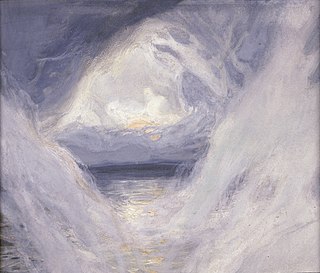
The Genesis creation narrative is the creation myth or narrative of both Judaism and Christianity, told in the Book of Genesis ch. 1–2. While the Jewish and Christian tradition has long maintained that the creation narrative is one comprehensive story, or history, "virtually all modern scholars," based on biblical criticism, regard the creation narrative as part of "a composite work," and made up of two stories, drawn from different sources.
Ancient Semitic religion encompasses the polytheistic religions of the Semitic peoples from the ancient Near East and Northeast Africa. Since the term Semitic represents a rough category when referring to cultures, as opposed to languages, the definitive bounds of the term "ancient Semitic religion" are only approximate but exclude the religions of "non-Semitic" speakers of the region such as Egyptians, Elamites, Hittites, Hurrians, Mitanni, Urartians, Luwians, Minoans, Greeks, Phrygians, Lydians, Persians, Medes, Philistines and Parthians.

In ancient near eastern cosmology, the firmament means a celestial barrier that separated the heavenly waters above from the Earth below. In biblical cosmology, the firmament is the vast solid dome created by God during the Genesis creation narrative to separate the primal sea into upper and lower portions so that the dry land could appear.

Babylonian religion is the religious practice of Babylonia. Babylonia's mythology was largely influenced by its Sumerian counterparts and was written on clay tablets inscribed with the cuneiform script derived from Sumerian cuneiform. The myths were usually either written in Sumerian or Akkadian. Some Babylonian texts were translations into Akkadian from Sumerian of earlier texts, but the names of some deities were changed.
In Mesopotamian mythology, the Tablet of Destinies was envisaged as a clay tablet inscribed with cuneiform writing, also impressed with cylinder seals, which, as a permanent legal document, conferred upon the god Enlil his supreme authority as ruler of the universe. It is a major literary motif in ancient Sumerian myths including Ninurta and the Turtle, and in Akkadian myths including Enuma Elish.
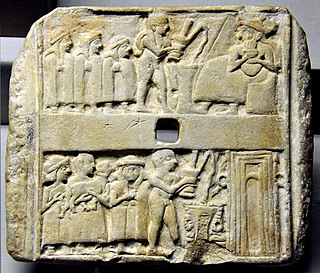
Sumerian religion was the religion practiced by the people of Sumer, the first literate civilization found in recorded history and based in ancient Mesopotamia, and what is modern day Iraq. The Sumerians widely regarded their divinities as responsible for all matters pertaining to the natural and social orders of their society.

The Abzu or Apsu, also called engur, is the name for fresh water from underground aquifers which was given a religious fertilising quality in ancient near eastern cosmology, including Sumerian and Akkadian mythology. Lakes, springs, rivers, wells, and other sources of fresh water were thought to draw their water from the abzu. In Mesopotamian mythology, it is referred to as the primeval sea below the void space of the underworld (Kur) and the earth (Ma) above.

Ušumgallu or Ushumgallu was one of the three horned snakes in Akkadian mythology, along with the Bašmu and Mušmaḫḫū. Usually described as a lion-dragon demon, it has been somewhat speculatively identified with the four-legged, winged dragon of the late 3rd millennium BCE.
Gilgamesh, Enkidu, and the Netherworld is one of five extant compositions of the Sumerian language about the deeds of the hero Gilgamesh. It was known to the ancients by its incipit, ud ri-a ud sud-rá ri-a or "In those days, in those faraway days". It spans 330 lines.
Jewish cosmology refers to a cluster of cosmological views held in Jewish systems of thought and theology in premodern times. This includes literature from the period of Second Temple Judaism, rabbinic literature, para-rabbinic literature, and more.
Early Greek cosmology refers to beliefs about the structure (cosmography) and origins (cosmogony) of the cosmos primarily from the 8th to 5th centuries BC before it was superseded by ancient Greek astronomy, which was demythologized and involved the systematic study of the world. The main features of early Greek cosmography are shared with those found in ancient near eastern cosmology. The basic elements of the cosmos include earth, heaven, the sea, and the netherworld (Tartarus), the first three of which corresponded to the gods Gaia, Ouranos, and Oceanus.

